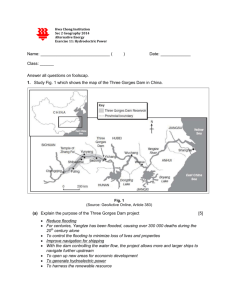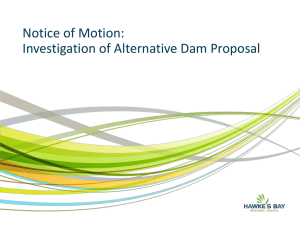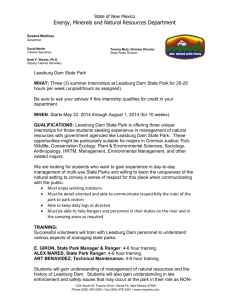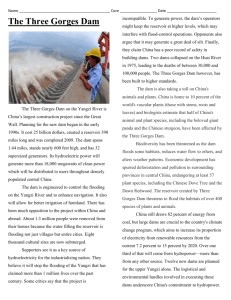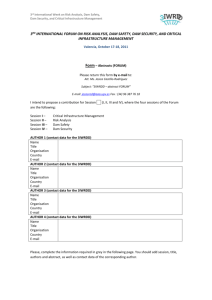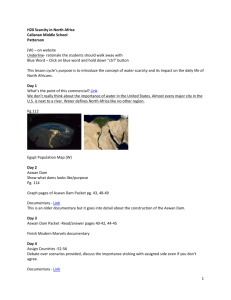Three Gorges Dam
advertisement
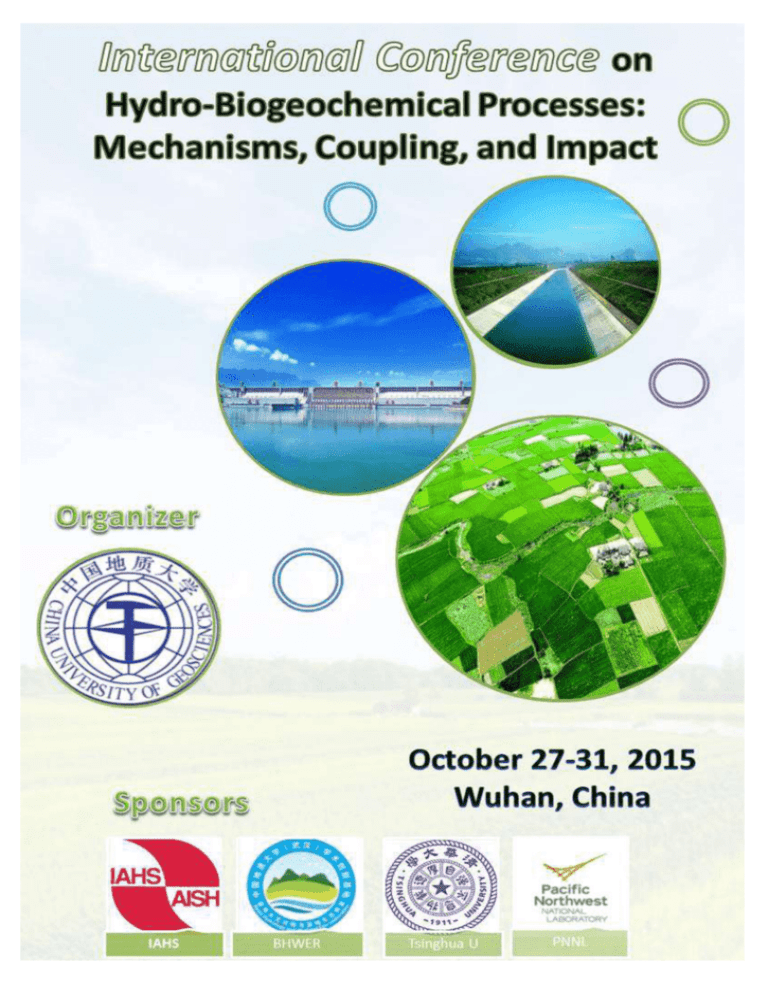
Introduction The hydro-biogeochemical interactions between terrestrial land and aquatic systems are of critical importance to freshwater sustainability, food and energy security, and aquatic biodiversity. Humans increasingly alter the land and aquatic hydro-biogeochemical cycles directly by replacement of native vegetation with agricultural crops, applying fertilizers to increase crop yields and by the discharge of untreated sewage, and indirectly by altering the water cycle (e.g., through dams and water withdrawals) and impacting downstream surface water and groundwater quality. Climate change is also expected to significantly affect hydro-biogeochemical cycling. Research is critically needed to improve the understanding of the dynamic coupling between hydrologic and biogeochemical processes under natural and human-induced changes, and to use this understanding towards improved models that can serve as tools for sustainable management of earth critical zone, groundwater and surface water systems in the emergent Anthropocene. This international workshop aims to bring together scientists from worldwide and various disciplines who share a common interest in addressing the challenges of understanding and managing the changing hydro-biogeochemistry in ecosystems under the pressure of diverse human impacts. The research goal is to gain holistic understanding of coupled hydrologic and biogeochemical processes across multiple spatiotemporal scales and to provide effective prediction and management solutions in an integrated fashion. This workshop will function as a platform to stimulate close collaborations, share ideas and visions, and conduct inter-comparison of data and models across various locations and scales from different disciplinary and societal perspectives. This conference makes a partial contribution to the PantaRhei initiative on Change in Hydrology and Society. CUG is taking a major initiative to study hydrological and biogeochemical processes that affect water supply, elemental cycling, ecological life, and contaminant transport in Jianghan plain where two world largest hydrological projects are operating: Three Gorge Dam, and China water supply project that transports water from South to North China (Beijing). There are various concerns regarding the impacts of these projects on ecology, environment, and economics. The Jianghan plain is also viewed as an Earth critical zone that is complexly affected by natural and human activities. The workshop will greatly contribute to this CUG initiative as well by providing insights on the interactions of hydrological, geochemical, biological processes in aquatic systems, Earth Critical zones, surface and groundwater interaction zones, ecological hot spots, etc. Workshop Agenda Date Oct. 26, 2015 Content Registration 8:30-12:00 8:30-8:50 8:50-9:30 General Session (Chair: Chongxuan Liu and Hongyi Li) Opening, and welcome remarks from host and sponsors All attendants 9:30-10:00 Picture time and Coffee Break 10:00-10:30 Murugesu Sivapalan 10:30-11:00 Georgia Destouni 11:00-11:30 Hongfu Yin 11:30-12:00 Yanxin Wang 12:00-1:00 Predictions in Catchment Biogeochemistry: Lessons Learned from Catchment Hydrology and PUB/PUC. Water from the Land Surface to the Coast: Deciphering Flow-Storage-Quality Changes and Their Drivers CUG-conducted CZOs in Middle Yangtze Area Groundwater Contamination and CZO Studies at Jianghan Plain Lunch 2:30-6:00 2:30-2:50 Self-Introduction Earth Critical Zone (Chair: Roy Haggerty, Dawen Yang) Julie Pett-Ridge Top-down, Bottom-up, and Longer-term Views of Critical Zone Evolution Based on Isotopic Tracers Hydrological and Biogeochemical Links across Mixed Land 2:50-3:10 Heather Golden Cover Landscapes: Insights from Watershed Modeling Approaches Oct. 27 3:10-3:30 Roy Haggerty The Role of Streams in Watershed Carbon Fluxes Dynamics of Spring Dissolved Organic Carbon Yield from 3:30-3:50 Fan Zhang Glacier Covered Catchments in the Upper Indus River Basin on the Third Pole 3:50-4:10 You-Kuan Zhang 4:10-4:30 Temporal Variation and Scaling of Hydro-Chemical Processes in Watershed Coffee break 4:30-4:50 Fuqiang Tian 4:50-5:10 Ciaran Harman 5:10-5:30 Jinzhong Yang The Role of Groundwater in Streamflow in a Headwater Catchment with Semi-Arid Climate A Unified Framework for Modeling Solute Transport at the Catchment Scale Saturated-Unsaturated Water Movement and Soil Salinity Control in a Large-Scale Irrigation District Thermal Imaging of Forest Canopy Temperatures in the 5:30-5:50 Christopher Still Pacific Northwest: Relationships with Biological and Biophysical Drivers and Ecosystem Carbon and Water Fluxes 5:50-6:10 Huaming Guo In-situ Mobilization and Transformation of Fe Oxides-Adsorbed Arsenate in Natural Groundwater in the Hetao Basin, China 6:30-7:30 Dinner 8:30-12:00 Groundwater-Surface Water Interaction Zone (Chair: John Zachara, Aaron Packman) A Multi-disciplinary Investigation of Coupled Hydrologic 8:30-8:50 and Biogeochemical Dynamics in the Groundwater-Surface John Zachara Water Interaction Zone of the Columbia River, a Major US River System Biogeochemistry and Microbial Ecology of the Columbia 8:50-9:10 Jim Fredrickson River Hanford Reach Groundwater-Surface Water Interaction Zone 9:10-9:30 Yamin Deng 9:30-9:50 Rui Ma Impact of Surface Water-Groundwater Interactions on Arsenic Transport in Shallow Aquifer in Jianghan Plain Surface Water and Groundwater in a Permafrost Zone, Northwestern China Multiscale Simulation of Hydrologic and Biogeochemical 9:50-10:10 Xiaofan Yang Processes in the Groundwater-Surface Water Interaction Zone 10:10-10:30 Oct. 28 Coffee Break 10:30-10:50 James Jawitz 10:50-11:10 Chongxuan Liu 11:10-11:30 Aaron Packman Modeling Emergent Archetypical Biogeochemical Response Patterns over Nested Time Scales System Approaches for Modeling Biogeochemical Processes and Rate Scaling in Hyporehic Zones Upscaling of Carbon and Nitrogen Dynamics in Rivers Mathematical Scaling of Biotic and AbioticInteractions in 11:30-11:50 Jinyun Tang Biogeochemical Modeling for Climate-Biogeochemistry Interactions 12:00-1:00 Lunch 2:30-6:00 Land-Atmosphere, Land-Ocean and Human-Nature Interaction (Chair: Ruby Leung, Qiuhong Tang) 2:30-2:50 Ruby Leung 2:50-3:10 Zhaoqing Yang Long-range Transport of Dust and Impacts on Clouds and Precipitation Assessing the Effect of Climate Change on Hydrological and Coastal Processes using a Coupled Modeling Approach The Toxic Outcome of Land-use and Climate Change in 3:10-3:30 Klaus Joehnk Lakes - a Modeling Perspective from Within and from Above Impact of Urban Land Uses on Coastal Environmental 3:30-3:50 Tao Yan 3:50-4:10 Hailong Li 4:10-4:30 4:30-4:50 Quality Estimating Submarine Groundwater Discharges into Laizhou Bay using Radium and Salinity as Tracers Coffee break Yi-Chen Yang Quantifying the Impact of Changing Hydro-Biogeochemical Cycle on Water Resources Management under Deep Uncertainties 4:50-5:10 Zhongping Lai 5:10-5:30 Qiuhong Tang 5:30-5:50 Dong Wang Jianghan Basin Formation, Evolution, and Human-Nature Interaction Combining Satellite and Ground Observations for Hydrological Monitoring and Forecasting in China A Hybrid Data-extending Approach for Hydrometeorological Series 6:30-7:30 Dinner 8:30-12:00 Aquatic Systems (Chair: Michael Rode, Mathew Hipsey) 8:30-8:50 Dawen Yang 8:50-9:10 Lihua Tang 9:10-9:30 Michael Rode 9:30-9:50 Tim Covino 9:50-10:10 Dingbao Wang 10:10-10:30 Coffee break 10:30-10:50 Hongyi Li 10:50-11:10 René Capell 11:10:10:50 Yonas Demissie 11:30-11:50 Matthew Hipsey Oct. 29 Anthropogenic Nitrogen Input and Its Impact on the Stream Water Quality in the Upper Yangtze River Basin Detecting the Nitrogen Export in Different Runoff Components from an Experimental Forest Watershed Continuous In-Stream Assimilatory Nitrate Uptake from High Frequency Sensor Measurements Determining the Multiple Controls over Nutrient Supply, Demand, and Limitation Temporal and Spatial Dynamics of Ephemeral Streams and Stream Biogeochemistry Rivers in Human-Earth Dialogue – An Earth System Modeling Perspective Flexible Approach to Water Quality Modeling within a Single Hydrological Concept Potential Use of Diagnostic and Dynamic Coupling of Models for Hydro-Biochemistry Modeling the Health of Aquatic Systems: the Changing Role of Prediction 12:00-1:00 Lunch 2:30-6:00 2:30-4:10 Individual session: Critical challenges and path forward for each session theme 4:10-4:30 Coffee break 4:30-5:20 Report to General Audience 5:20-5:50 Congqiang Liu 6:30-7:30 dinner Oct.30-31 Discussion Session Visit Three Gorge Dam Area Closing and NSFC Earth Critical Zone Research Field Trip A field trip to visit the Three Gorges Dam and Xiling Gorge will be arranged after the workshop. Participation is optional. Please indicate whether you will participate in the field trip in the return receipt. ◆Three Gorges Dam The Three Gorges Dam is the largest dam in the world with purposes to control the floods in the areas along the Yangtze River, and to generate hydropower for much of the eastern and central China. The Three Gorges Dam is a hydroelectric dam that spans the Yangtze River by the town of Sandouping, located in Yiling District, Yichang, Hubei province, China (Figure 1). The Three Gorges Dam is the world's largest power station in terms of installed capacity (22,500 MW) (Figure 2 and Figure 3). The dam has the largest operating hydroelectric facility in terms of annual energy generation, generating 83.7 TWh in 2013 and 98.8 TWh in 2014. The dam is also intended to increase the Yangtze River's shipping capacity and reduce the potential for floods downstream by providing flood storage space. Figure1.Location of the Three Gorges Dam Made of concrete and steel, the dam is 2,335 meters long and the top of the dam is 185 meters above sea level. The project used 27.2 million cubic meters of concrete (mainly for the dam wall), 463,000 tonnes of steel (enough to build 63 Eiffel Towers) and removed about 102.6 million cubic meters of earth. The concrete dam wall is 181 meters high above the rock basis. When the water level is at its maximum of 175 meters above sea level, which is 110 meters higher than the river level downstream, the dam reservoir is on average about 660 kilometers in length and 1.12 kilometers in width. It contains 39.3km3 of water and has a total surface area of 1,045 square kilometers. Figure2.The Three Gorges Dam Figure3. Panorama of the Three Gorges Dam The Three Gorges, one of the world's most famous scenic sites around Qutang, Wuxian and Xiling, features breathtaking scenery which attracts hundreds ofthousands of domestic and international tourists every year. The charming scenery is left untouched following the damming of the mid-section of the Xiling Gorge. Figure 4. The scenery of Xiling Gorge in Yangtze River

